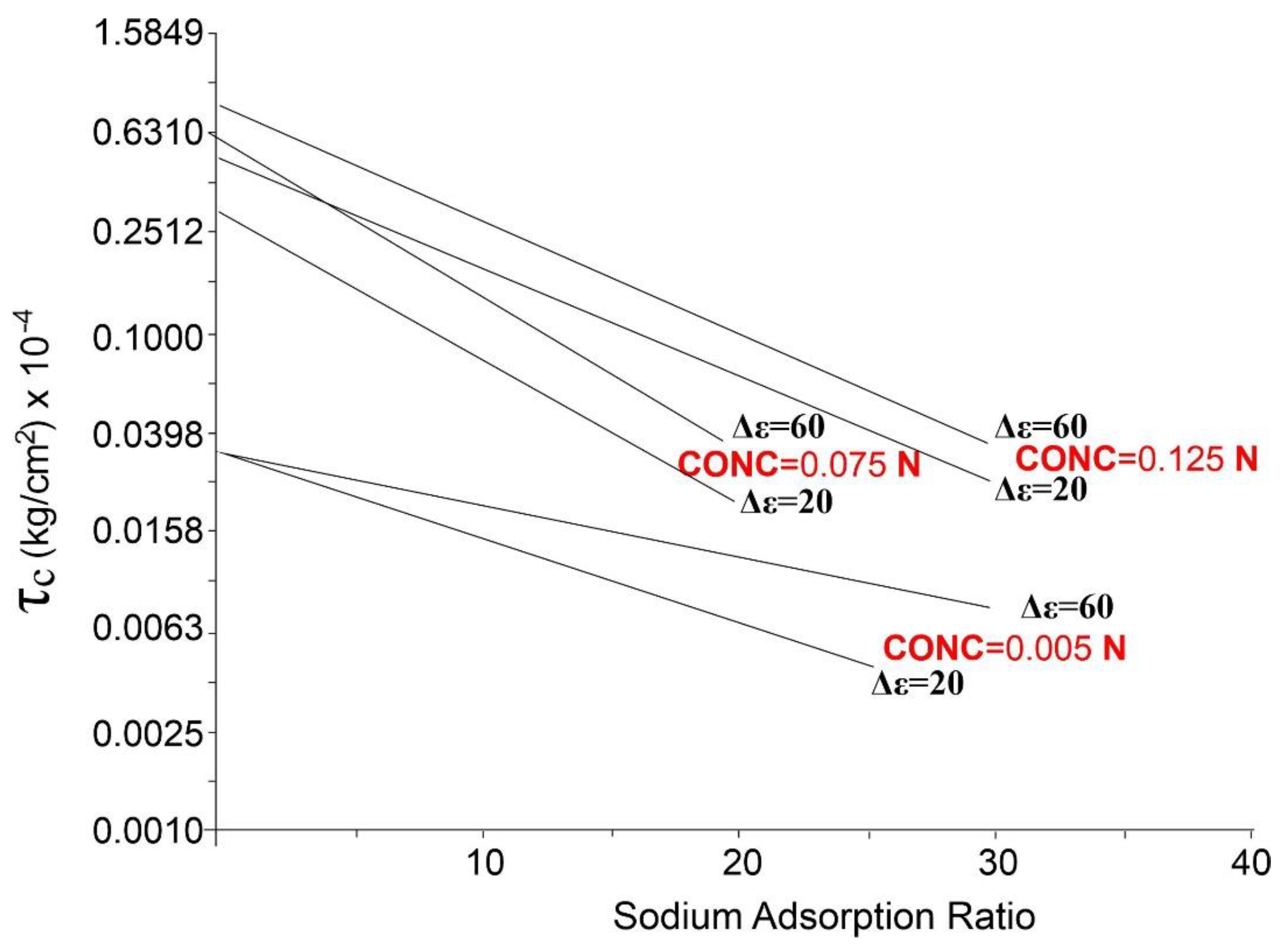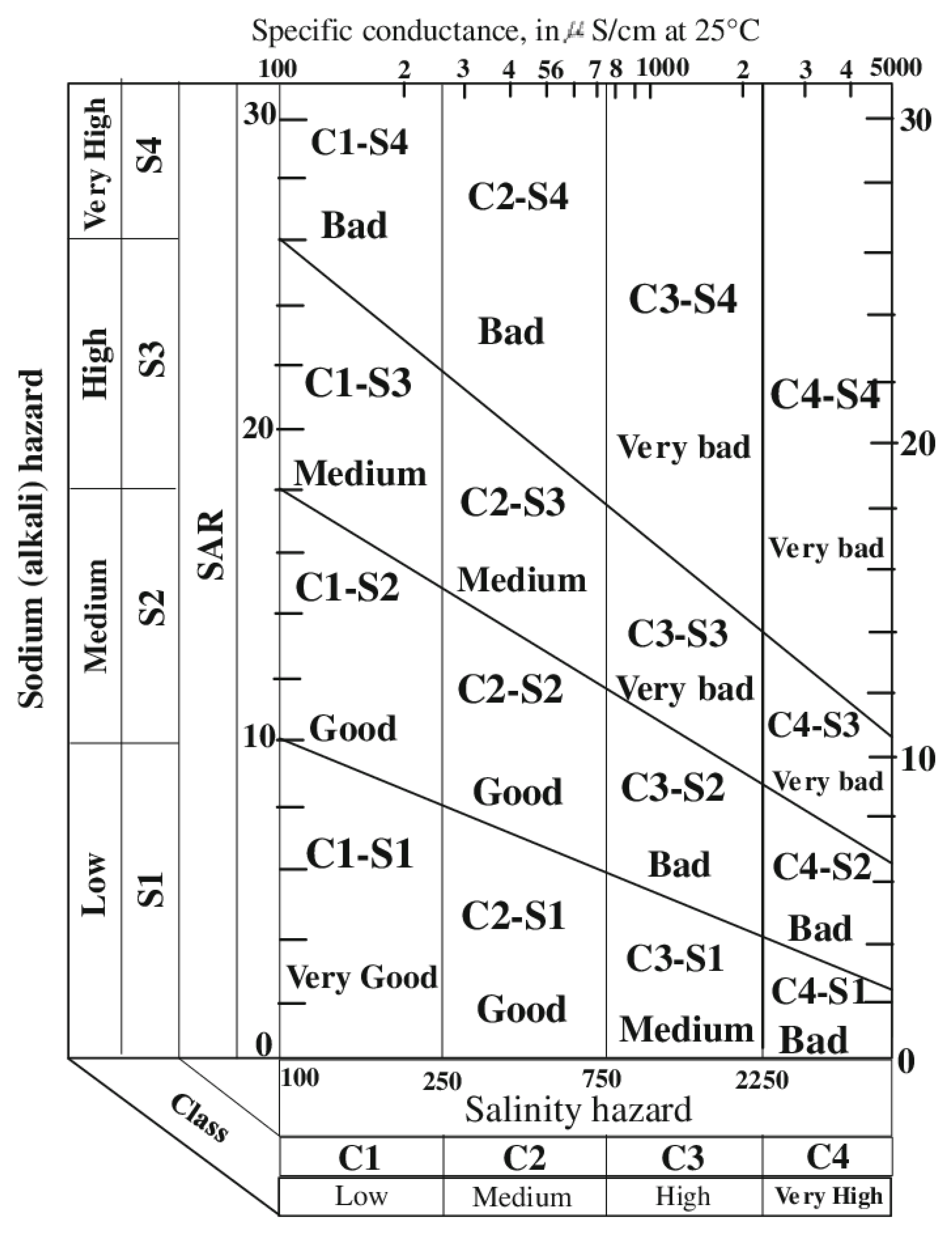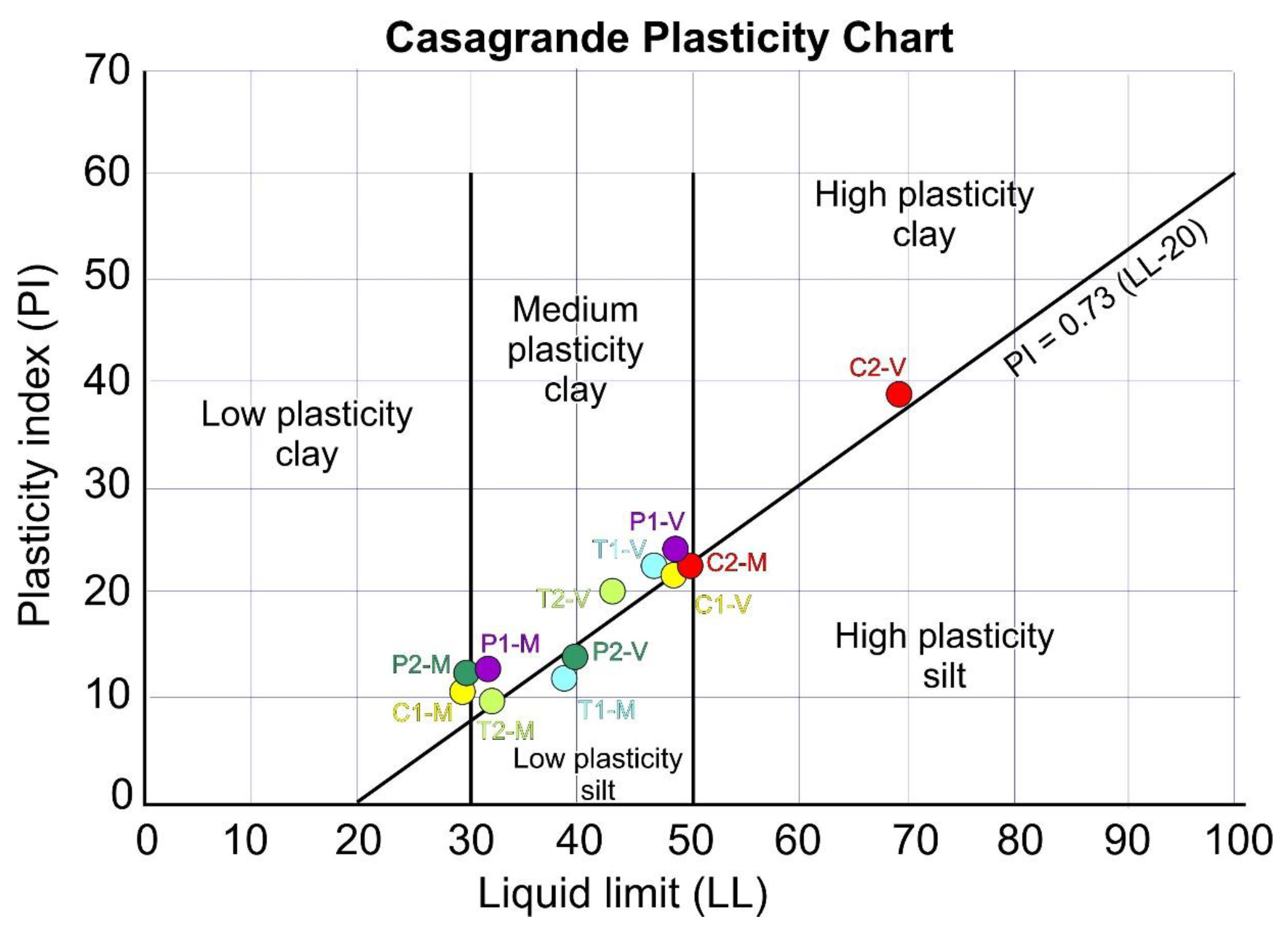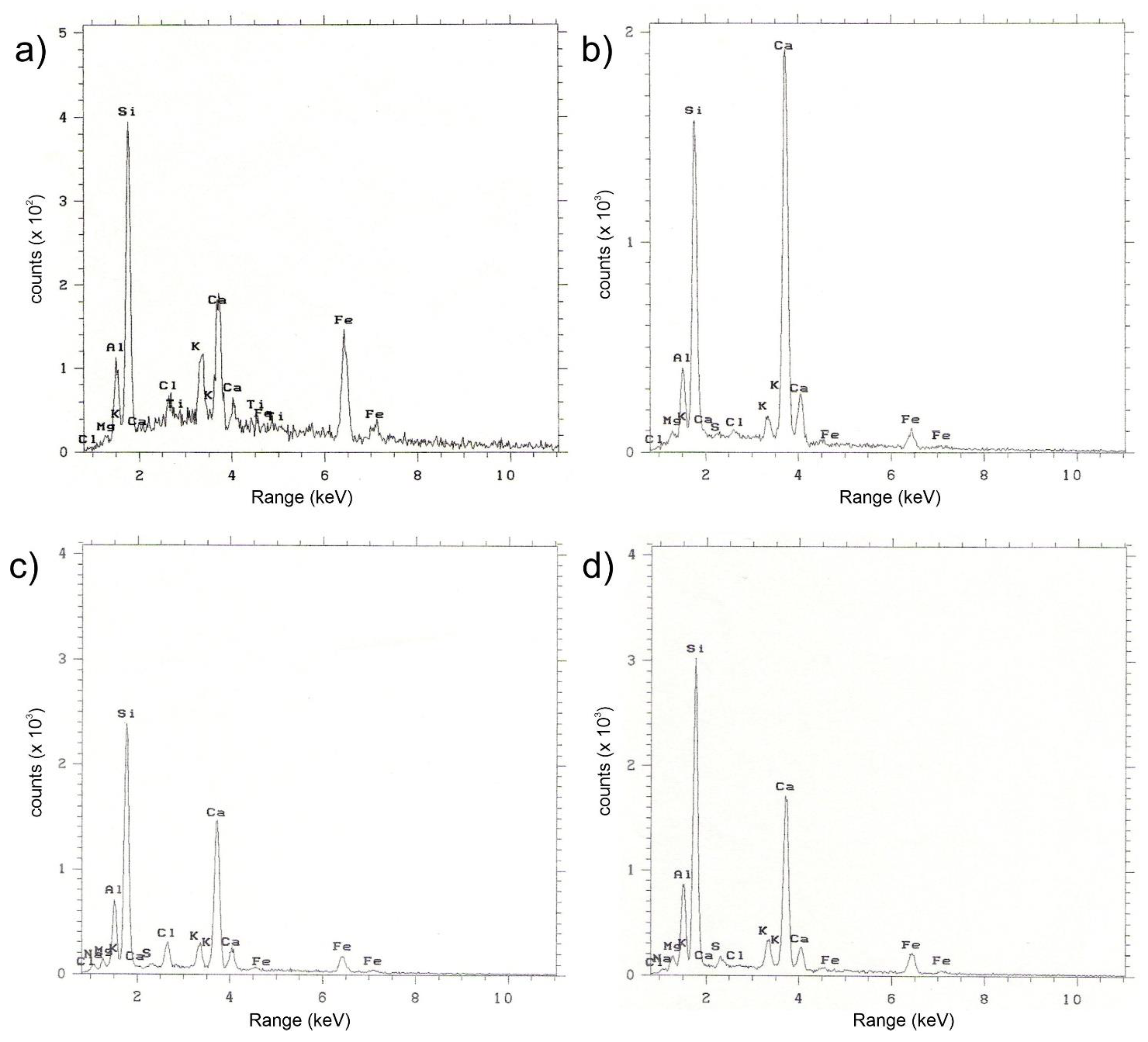The Role of Wastewater in Controlling Fluvial Erosion Processes on Clayey Bedrock
Abstract
:1. Introduction
2. Materials and Methods
2.1. Study Area
- (i)
- the intense agricultural activity on the slopes, which has triggered intense erosion phenomena and sometimes landslides by reducing the concentration time and consequently increasing the volumes and speed of running waters;
- (ii)
- the morphological modifications of the riverbeds (narrowing of the river sections, rectification of the riverbeds, creation of riverbank consolidation works) which have led to increases in the speed of the outflows and sudden deepening processes;
- (iii)
- the presence of “barriers” (check dams, groins, etc.) and hydraulic works built for irrigation and/or hydroelectric purposes, which have produced, sometimes in just over a decade, downcutting of the order of 10–15 m [51] sometimes compromising or even causing the collapse of the infrastructure itself.
2.2. Chemical Analyses
2.2.1. Sodium Absorption Ratio (SAR) and Soil Salt Concentration
2.2.2. Scanning Electron Microscopy (SEM)
2.2.3. Mineralogical Analyses
- -
- Wavelength: Kα of Copper (Cu)
- -
- 2-theta angle: 2–60°
- -
- Angular velocity: 2°/min
- -
- Time constant = 2″
- -
- X-ray generator operating at 40 Kv × 20 mAR = 4 × 102; from 2° to 35°)
2.2.4. Geotechnical Analyses
- -
- the Liquid Limit (LL), defined as the water content at which the behavior of a clayey soil change from the plastic state to the liquid state;
- -
- the Plastic Limit (PL), which represents the minimum water content for which the soil can be plastically deformed without deformation;
- -
- the difference between the LL and the PL, called Plasticity Index (PI), which defines the size of the range of water contents where the soil exhibits plastic properties;
- -
- the Consistency Index (CI) calculated as CI = (LL − W)/(LL − PL) where W is the natural water content.
3. Results
3.1. Chemical Analyses and SAR Evaluation
3.2. Mineralogical, Geotechnical and SEM Analyses
4. Discussion
5. Conclusions
- -
- SAR analyses provided results in line with those geotechnical; although the variations observed are less consistent in absolute terms, they nonetheless show a positive trend proceeding from upstream to downstream in all the sites analyzed. This fact confirms that the increase in salt concentration can also affect the soil’s shear resistance to erosion.
- -
- The SEM analyses were found to be of little significance; carried out above all to detect any traces of polluting elements and their possible crystalline aggregations in the samples, however, they did not show particular variations except for the presence of significant quantities of chlorine, usually associated with the presence of pollutants of industrial origin.
Author Contributions
Funding
Institutional Review Board Statement
Informed Consent Statement
Data Availability Statement
Conflicts of Interest
References
- Preece, R.C.; Bridgland, D.R. Holywell Coombe, Folkestone: A 13,000 year history of an English Chalkland Valley. Quat. Sci. Rev. 1999, 18, 1075–1125. [Google Scholar] [CrossRef]
- Brocard, G.Y.; van der Beek, P.A.; Bourlès, D.L.; Siame, L.L.; Mugnier, J.L. Long-term fluvial incision rates and postglacial river relaxation time in the French Western Alps from 10Be dating of alluvial terraces with assessment of inheritance, soil development and wind ablation effects. Earth Planet. Sci. Lett. 2003, 209, 197–214. [Google Scholar] [CrossRef] [Green Version]
- Schumm, S.A. River response to baselevel change: Implications for sequence stratigraphy. J. Geol. 1993, 101, 279–294. [Google Scholar] [CrossRef]
- Holbrook, J.; Scott, R.W.; Oboh-Ikuenobe, F.E. Base-level buffers and buttresses: A model for upstream versus downstream control on fluvial geometry and architecture within sequences. J. Sediment. Res. 2006, 76, 162–174. [Google Scholar] [CrossRef] [Green Version]
- Merritts, D.J.; Vincent, K.R.; Wohl, E.E. Long river profiles, tectonism, and eustasy: A guide to interpreting fluvial terraces. J. Geophys. Res. 1994, 99, 14031–14050. [Google Scholar] [CrossRef]
- Schumm, S.A.; Dumont, J.F.; Holbrook, J.M. Active Tectonics and Alluvial Rivers; Cambridge University Press: Cambridge, UK, 2000; p. 276. [Google Scholar]
- Surian, N.; Rinaldi, M. Morphological response to river engineering and management in alluvial channels in Italy. Geomorphology 2003, 50, 307–326. [Google Scholar] [CrossRef]
- Buccolini, M.; Gentili, B.; Materazzi, M.; Aringoli, D.; Pambianchi, G.; Piacentini, T. Human impact and slope dynamics evolutionary trends in the monoclinal relief of Adriatic area of central Italy. Catena 2007, 71, 96–109. [Google Scholar] [CrossRef]
- Aringoli, D.; Buccolini, M.; Coco, L.; Dramis, F.; Farabollini, P.; Gentili, B.; Giacopetti, M.; Materazzi, M.; Pambianchi, G. The effects of in-stream gravel mining on river incision: An example from Central Adriatic Italy. Zeitschrift Geomorphol. 2015, 59, 95–107. [Google Scholar] [CrossRef]
- Collier, M.; Webb, R.H.; Schmidt, J.C. Dams and Rivers: A Primer on the Downstream Effects of Dams; US Department of the Interior: Washington, DC, USA, 1996. [Google Scholar]
- Petit, F.; Poinsart, D.; Bravard, J.P. Channel incision, gravel mining and bedload transport in the Rhône river upstream of Lyon, France (“canal de Miribel”). CATENA 1996, 26, 209–226. [Google Scholar] [CrossRef]
- Kondolf, G.M. Hungry water: Effects of dams and gravel mining on river channels. Environ. Manage. 1997, 21, 533–551. [Google Scholar] [CrossRef]
- García-Ruiz, J.M.; Valero-Garcés, B.L. Historical Geomorphic Processes and Human Activities in the Central Spanish Pyrenees. Mt. Res. Dev. 1998, 18, 309–320. [Google Scholar] [CrossRef]
- Hudson, P.F.; Kesel, R.H. Channel migration and meander-bend curvature in the lower Mississippi River prior to major human modification. Geology 2000, 28, 531–534. [Google Scholar] [CrossRef]
- Hudson, P.F.; Middelkoop, H.; Stouthamer, E. Flood management along the Lower Mississippi and Rhine Rivers (The Netherlands) and the continuum of geomorphic adjustment. Geomorphology 2008, 101, 209–236. [Google Scholar] [CrossRef]
- Leopold, L.B. River Channel Change with Time: An Example: Address as Retiring President of The Geological Society of America, Minneapolis, Minnesota, November 1972. GSA Bull. 1973, 84, 1845–1860. [Google Scholar] [CrossRef]
- Gregory, K.J.; Park, C. Adjustment of river channel capacity downstream from a reservoir. Water Resour. Res. 1974, 10, 870–873. [Google Scholar] [CrossRef]
- Williams, G.P. The Case of the Shrinking Channels: The North Platte and Platte Rivers in Nebraska; US Department of the Interior: Washington, DC, USA, 1978. [Google Scholar]
- Petts, G.E. Complex response of river channel morphology subsequent to reservoir construction. Prog. Phys. Geogr. Earth Environ. 1979, 3, 329–362. [Google Scholar] [CrossRef]
- Williams, G.P.; Wolman, M.G. Downstream Effects of Dams on Alluvial Rivers; US Government Printing Office: Washington, DC, USA, 1984. [Google Scholar]
- Andrews, E.D. Downstream effects of Flaming Gorge Reservoir on the Green River, Colorado and Utah. GSA Bull. 1986, 97, 1012–1023. [Google Scholar] [CrossRef]
- Knighton, A.D. Channel bed adjustment along mine-affected rivers of northeast Tasmania. Geomorphology 1991, 4, 205–219. [Google Scholar] [CrossRef]
- Buccolini, M.; Gentili, B.; Materazzi, M.; Piacentini, T. Late Quaternary geomorphological evolution and erosion rates in the clayey peri-Adriatic belt (central Italy). Geomorphology 2010, 116, 145–161. [Google Scholar] [CrossRef]
- Materazzi, M.; Gentili, B.; Aringoli, D.; Farabollini, P.; Pambianchi, G. Elements of slope and fluvial dynamics as evidence of late holocene climatic fluctuations in the central adriatic sector, Italy. Geogr. Fis. Din. Quat. 2010, 33, 193–204. [Google Scholar]
- Bravard, J.P.; Amoros, C.; Pautou, G.; Bornette, G.; Bournaud, M.; Creuze Des Chatelliers, M.; Gibert, J.; Peiry, G.L.; Perrin, O.; Tachet, H. River incision in south-east France morphological phenomena and ecological effects. Regul. Rivers Res. Manag. 1997, 13, 75–90. [Google Scholar] [CrossRef]
- Brown, A.V.; Lyttle, M.M.; Brown, K.B. Impacts of Gravel Mining on Gravel Bed Streams. Trans. Am. Fish. Soc. 1998, 127, 979–994. [Google Scholar] [CrossRef]
- Marchetti, M. Environmental changes in the central Po Plain (northern Italy) due to fluvial modifications and anthropogenic activities. Geomorphology 2002, 44, 361–373. [Google Scholar] [CrossRef]
- Simon, A.; Rinaldi, M. Disturbance, stream incision, and channel evolution: The roles of excess transport capacity and boundary materials in controlling channel response. Geomorphology 2006, 79, 361–383. [Google Scholar] [CrossRef]
- Mossa, J.; Marks, S.R. Pit Avulsions and Planform Change on a Mined River Floodplain: Tangipahoa River, Louisiana. Phys. Geogr. 2011, 32, 512–532. [Google Scholar] [CrossRef]
- Alighalehbabakhani, F.; Miller, C.J.; Selegean, J.P.; Barkach, J.; Sadatiyan Abkenar, S.M.; Dahl, T.; Baskaran, M. Estimates of sediment trapping rates for two reservoirs in the Lake Erie watershed: Past and present scenarios. J. Hydrol. 2017, 544, 147–155. [Google Scholar] [CrossRef]
- Mekonnen, M.; Keesstra, S.D.; Baartman, J.E.; Ritsema, C.J.; Melesse, A.M. Evaluating sediment storage dams: Structural off-site sediment trapping measures in northwest ethiopia. Cuad. Investig. Geográfica 2015, 41, 7–22. [Google Scholar] [CrossRef] [Green Version]
- Issa, I.E.; Al-ansari, N.; Knutsson, S.; Sherwany, G. Monitoring and Evaluating the Sedimentation Process in Mosul Dam Reservoir Using Trap Efficiency Approaches. Engineering 2015, 7, 190–202. [Google Scholar] [CrossRef] [Green Version]
- Kummu, M.; Lu, X.X.; Wang, J.J.; Varis, O. Geomorphology Basin-wide sediment trapping ef fi ciency of emerging reservoirs along the Mekong. Geomorphology 2010, 119, 181–197. [Google Scholar] [CrossRef]
- Mulu, A.; Dwarakish, G.S. Different Approach for Using Trap Efficiency for Estimation of Reservoir Sedimentation. An Overview. Aquat. Procedia 2015, 4, 847–852. [Google Scholar] [CrossRef]
- Yang, X.; Lu, X.X. Geomorphology Estimate of cumulative sediment trapping by multiple reservoirs in large river basins: An example of the Yangtze River basin. Geomorphology 2014, 227, 49–59. [Google Scholar] [CrossRef]
- Conoscenti, C.; Martinello, C.; Alfonso-Torreño, A.; Gómez-Gutiérrez, Á. Predicting sediment deposition rate in check-dams using machine learning techniques and high-resolution DEMs. Environ. Earth Sci. 2021, 80, 380. [Google Scholar] [CrossRef]
- Arulanandan, K.; Sargunam, A.; Loganathan, P.; Krone, R. Application of Chemical and Electrical parameters to prediction of erodibility. In Soil Erosion: Causes and Mechanisms; Prevention and Control, Special Rep. 135; Highway Research Board: Washington, DC, USA, 1973; pp. 42–51. [Google Scholar]
- Osman, A.M.; Thorne, C.R. Riverbank Stability Analysis. I: Theory. J. Hydraul. Eng. 1988, 114, 134–150. [Google Scholar] [CrossRef]
- Esposito, L.; Diogene, G. Effetti dell’inquinamento sul comportamento meccanico dei terreni. Quad. dtai Geol. Appl. 2002, 9, 9–20. [Google Scholar]
- Farabollini, P.; Aringoli, D.; Gentili, B.; Materazzi, M.; Pambianchi, G. Processi di approfondimento dell’erosione in alveo ed effetti dell’inquinamento nei fiumi delle Marche centro-meridionali (Italia centrale). Alp. Mediterr. Quat. 2008, 21, 317–330. [Google Scholar]
- Dramis, F.; Pambianchi, G.; Nesci, O.; Consoli, M. Il ruolo di elementi strutturali transversali nell’evoluzione tettonico-sedimentaria e geomorfologica della regione marchigiana. Stud. Geol. Camerti 1991, 11, 287–293. [Google Scholar]
- Coltorti, M.; Consoli, M.; Dramis, F.; Gentili, B.; Pambianchi, G. Evoluzione geomorfologica delle piane alluvionali delle Marche Centro-Meridionali. Geogr. Fis. Dinam. Quat. 1991, 14, 87–100. [Google Scholar]
- Ciccacci, S.; D’Alessandro, L.; Dramis, F.; Fredi, P.; Pambianchi, G. Geomorphological and neotectonic evolution of the Umbria-Marche ridge, northern sector. Stud. Geol. Camerti 1985, 10, 7–15. [Google Scholar]
- Dramis, F. Il ruolo dei sollevamenti tettonici a largo raggio nella genesi del rilievo appenninico. Stud. Geol. Camerti 1992, 1, 9–15. [Google Scholar]
- Bartolini, G.; Pisano, A.; Punta, E.; Usai, E. A survey of applications of second-order sliding mode control to mechanical systems. Int. J. Control 2003, 76, 875–892. [Google Scholar] [CrossRef]
- Gentili, B.; Pambianchi, G. Erosione e sedimentazione negli alti bacini fluviali delle Marche centro-meridionali. Atti Convegno: I corsi d’acqua minori dell’Italia appenninica, Boll. Mus.St. Nat. Lunigiana (Aulla) 1988, 35–40. [Google Scholar]
- Amici, M.; Spina, R. Campo Medio della Precipitazione Annuale e Stagionale Sulle Marche per il Periodo 1950–2000; Centro di Ecologia e Climatologia—Osservatorio Geofisico Sperimentale: Macerata, Italy, 2002; Volume 103. [Google Scholar]
- Gentilucci, M.; Bufalini, M.; D’aprile, F.; Materazzi, M.; Pambianchi, G. Comparison of data from rain gauges and the IMERG product to analyse precipitation in mountain areas of central Italy. ISPRS Int. J. Geo-Inf. 2021, 10, 795. [Google Scholar] [CrossRef]
- Gentilucci, M.; Materazzi, M.; Pambianchi, G.; Burt, P.; Guerriero, G. Temperature variations in Central Italy (Marche region) and effects on wine grape production. Theor. Appl. Climatol. 2020, 140, 303–312. [Google Scholar] [CrossRef]
- Materazzi, M.; Bufalini, M.; Gentilucci, M.; Pambianchi, G.; Aringoli, D.; Farabollini, P. Landslide hazard assessment in a monoclinal setting (Central italy): Numerical vs. geomorphological approach. Land 2021, 10, 624. [Google Scholar] [CrossRef]
- Brunelli, M.; Farabollini, P. Fenomeni di erosione e dinamica fluviale in alcuni fiumi delle Marche centro-meridionali. In Dinamica Fluviale; Brunelli &Farabollini, Ed.; Ordine dei Geologi delle Marche: Ancona, Italy, 2005; pp. 31–64. [Google Scholar]
- Arulanandan, K.; Gillogley, E.; Tully, R. Development of a Quantitative Method to Predict Critical Shear Stress and Rate of Erosion of Natural Undisturbed Cohesive Soils; California Univ. Davis Dept. of Civil Engineering: Davis, CA, USA, 1980. [Google Scholar]
- Casagrande, A. Notes on the design of the liquid limit device. Geotechnique 1932, 8, 84–91. [Google Scholar] [CrossRef]
- Schofield, A.; Wroth, P. Critical State Soil Mechanics; Cambridge University: Cambridge, UK, 1988. [Google Scholar]
- Chiesa, G. Inquinamento delle Acque Sotterranee. Metodi di Indagine e di Studio per la Bonifica e la Gestione delle Acque Inquinate; Hoelpi Editore: Milano, Italy, 1994. [Google Scholar]









| Samples | ||||||||||||
|---|---|---|---|---|---|---|---|---|---|---|---|---|
| Chemical Parameters | T1-M Tenna r. | T1-V Tenna r. | T2-M Tenna r. | T2-V Tenna r. | C1-M Chienti r. | C1-V Chienti r. | C2-M Chienti r. | C2-V Chienti r. | P1-M Potenza r. | P1-V Potenza r. | P2-M Potenza r. | P2-V Potenza r. |
| pH | 7.5 | 7.5 | 7.9 | 7.8 | 7.6 | 7.6 | 7.3 | 7.3 | 7.5 | 7.5 | 7.7 | 7.6 |
| Calcium Ca (mg/L) | 107.7 | 108.8 | 80.4 | 82.9 | 109.2 | 110.6 | 81.6 | 83.9 | 102.3 | 104.6 | 80.5 | 86.2 |
| Magnesium Mg (mg/L) | 20.1 | 22.1 | 5.5 | 5.31 | 7.4 | 8.6 | 5.7 | 5.4 | 7.1 | 8.1 | 4.7 | 4.2 |
| Sodium Na (mg/L) | 25.4 | 28.6 | 15.5 | 17.1 | 12.5 | 15.2 | 12.6 | 14 | 11.3 | 13.6 | 12.7 | 15.8 |
| Potassium K (mg/L) | 8.7 | 8.9 | 6.5 | 6.6 | 5.6 | 6.7 | 6.8 | 7.1 | 5.9 | 6.4 | 7.2 | 7.7 |
| Bicarbonates HCO3 (mg/L) | 318 | 322 | 244 | 260 | 330 | 338 | 258 | 264 | 311 | 315 | 275 | 280 |
| Chlorides Cl (mg/L) | 55.9 | 58.8 | 25.1 | 29.1 | 20.6 | 22.4 | 19.3 | 23.4 | 9.51 | 13.4 | 15.5 | 17.1 |
| Sulphates SO4 (mg/L) | 86.1 | 86.2 | 26.1 | 24.2 | 36.7 | 41.3 | 23.3 | 22.6 | 27.5 | 27.4 | 17.8 | 23.2 |
| Nitrites NO2 (mg/L) | absent | absent | absent | absent | 0.05 | 0.04 | 0.11 | 0.11 | 0.27 | 0.28 | absent | absent |
| Nitrates NO3 (mg/L) | 22.3 | 22.6 | 1.73 | 1.79 | 2.6 | 2.6 | 25.1 | 25.2 | 1.1 | 1.2 | 3.2 | 3.3 |
| Cyanides CN (mg/L) | absent | absent | absent | absent | absent | absent | absent | absent | absent | absent | absent | absent |
| Ammonia NH3 (mg/L) | absent | absent | absent | absent | absent | absent | absent | absent | absent | absent | absent | absent |
| Phosphates PO4 (mg/L) | absent | absent | absent | absent | absent | absent | 0.19 | 0.21 | absent | absent | absent | absent |
| Electrical conductivity (μS/cm) | 911 | 930 | 482 | 495 | 578 | 582 | 463 | 475 | 440 | 457 | 413 | 423 |
| Sodium Adsorption Ratio SAR | 0.59 | 0.65 | 0.45 | 0.49 | 0.31 | 0.37 | 0.36 | 0.40 | 0.29 | 0.34 | 0.37 | 0.45 |
| Samples | |||||||||||||
|---|---|---|---|---|---|---|---|---|---|---|---|---|---|
| Geotechnical Parameters | T1-M Tenna r. | T1-V Tenna r. | T2-M Tenna r. | T2-V Tenna r. | C1-M Chienti r. | C1-V Chienti r. | C2-M Chienti r. | C2-V Chienti r. | P1-M Potenza r. | P1-V Potenza r. | P2-M Potenza r. | P2-V Potenza r. | |
| Water content | 17.10 | 19.20 | 24.40 | 25.90 | 25.40 | 29.30 | 15.30 | 14.90 | 14.30 | 17.70 | 22.50 | 25.30 | |
| Specific weight (g/cm3) | 1.88 | 1.86 | 1.96 | 2.01 | 1.92 | 1.87 | 2.23 | 2.30 | 1.73 | 1.77 | 1.82 | 1.82 | |
| ATTERBERG LIMITS | Liquid Limit—LL | 38.11 | 46.57 | 31.27 | 42.39 | 29.54 | 47.97 | 49.11 | 68.37 | 31.25 | 48.98 | 31.25 | 39.11 |
| Plastic Limit—PL | 26.15 | 23.69 | 21.44 | 22.36 | 17.73 | 24.87 | 26.77 | 29.41 | 18.26 | 26.64 | 18.31 | 25.23 | |
| Consistency Index—CI | 1.76 | 1.20 | 0.70 | 0.82 | 0.35 | 0.81 | 1.51 | 1.37 | 1.30 | 1.40 | 0.68 | 0.99 | |
| Plasticity Index—PI | 11.96 | 22.88 | 9.83 | 20.03 | 11.81 | 23.10 | 22.34 | 38.96 | 12.99 | 22.34 | 12.94 | 13.88 | |
Disclaimer/Publisher’s Note: The statements, opinions and data contained in all publications are solely those of the individual author(s) and contributor(s) and not of MDPI and/or the editor(s). MDPI and/or the editor(s) disclaim responsibility for any injury to people or property resulting from any ideas, methods, instructions or products referred to in the content. |
© 2023 by the authors. Licensee MDPI, Basel, Switzerland. This article is an open access article distributed under the terms and conditions of the Creative Commons Attribution (CC BY) license (https://creativecommons.org/licenses/by/4.0/).
Share and Cite
Bufalini, M.; Aringoli, D.; Bendia, F.; Farabollini, P.; Gentilucci, M.; Lampa, F.; Martinello, C.; Materazzi, M.; Pambianchi, G. The Role of Wastewater in Controlling Fluvial Erosion Processes on Clayey Bedrock. Land 2023, 12, 227. https://doi.org/10.3390/land12010227
Bufalini M, Aringoli D, Bendia F, Farabollini P, Gentilucci M, Lampa F, Martinello C, Materazzi M, Pambianchi G. The Role of Wastewater in Controlling Fluvial Erosion Processes on Clayey Bedrock. Land. 2023; 12(1):227. https://doi.org/10.3390/land12010227
Chicago/Turabian StyleBufalini, Margherita, Domenico Aringoli, Fabrizio Bendia, Piero Farabollini, Matteo Gentilucci, Francesco Lampa, Chiara Martinello, Marco Materazzi, and Gilberto Pambianchi. 2023. "The Role of Wastewater in Controlling Fluvial Erosion Processes on Clayey Bedrock" Land 12, no. 1: 227. https://doi.org/10.3390/land12010227






